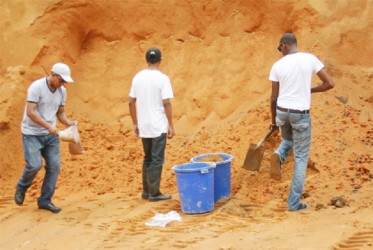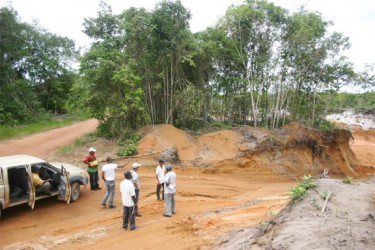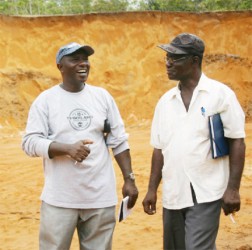Three employees of Ground Structures Engineering Consultant Company on Tuesday took soil samples from the area where Bai Shan Lin has been controversially mining laterite at Moblissa on the Linden/Soesdyke Highway.
According to the technicians, the results from testing the soil samples would be used to help the relevant authorities to determine the proper soil mixture that would be required to adequately repair the access road that allows Moblissa farmers to take their produce to market.

samples at the laterite pit.
Arthur Reynolds, the Community Development Committee Chairman at Moblissa, who accompanied the technicians to the mining area, said Bai Shan Lin began mining at the location around December last year to obtain soil to build up the swampy area on which it plans to build a wood processing plant and to construct a five-mile roadway on the opposite side of the highway that would allow the expatriate company to access the Demerara River.
Reynolds said the heavy trucks Bai Shan Lin used have damaged three miles of the seven-mile road that is used by Moblissa farmers to access their farm lands. He said laterite constituted an important component of the road, but what was now being used by Bai Shan Lin was inadequate to properly repair the portion of roadway that has been damaged.
He also pointed to a serious environmental concern of potential land slippage that could make the road impassable in the current rainy season.
Maurice Butters, Chairman of the Region Ten Health and Environment Committee, who also visited the location on Tuesday, echoed Reynolds’ concern about the serious threat of land slippage that could make the road impassable.

Butters, who has been assigned by the Region Ten council to monitor Bai Shan Lin’s operations at Moblissa, said that when he last visited the area on April 8, the southern portion of the pit was about 40 ft from the road but yesterday, he estimated it to be about 25 ft away.
According to the technicians from the Georgetown-based Ground Structures Engineering Consultant Company, the roughly rectangular pit is about 60 metres in depth with perimeter dimensions of roughly 300 x 100 metres.
Butters said the Region Ten Democratic Council had thoroughly discussed the Bai Shan Lin operation after Moblissa residents voiced environmental concerns about the company’s intention to set up a wood processing factory in the area.
He said the RDC is concerned that no environmental impact study had been done. He added that Region Ten representatives met officials from the Ministry of Natural Resources and other stakeholders, including the Guyana Forestry Commission and Guyana Geology and Mines Commission but it appears as though the region’s concerns “have fallen on deaf ears”.






